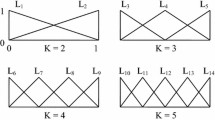Abstract
The problem of reduction of training samples for synthesizing diagnostic models has been solved in the paper. The method of dimension reduction of training sample based on association rules has been proposed. It includes the implementation of stages of reduction of instances, features and superfluous terms, uses information on extracted association rules for evaluation of informativeness of features. The proposed method allows to create a partition of feature space with a fewer number of instances compared to the original sample, which in turn makes the synthesis of easier and more convenient for perception diagnostic models possible. The developed method has been implemented in the developed software and was used for the practical problem solving of reduction of training sample for the synthesis of a diagnostic model of confectionery products quality.
Similar content being viewed by others
References
Encyclopedia of Survey Research Methods, Lavrakas, P.J., Ed., Thousand Oaks: Sage Publications, 2008.
Chaudhuri, A. and Stenger, H., Survey Sampling Theory and Methods, New York: Chapman & Hall, 2005.
Lee, J.A. and Verleysen, M., Nonlinear Dimensionality Reduction, New York: Springer, 2007.
Jensen, R. and Shen, Q., Computational Intelligence and Feature Selection: Rough and Fuzzy Approaches, Hoboken: John Wiley & Sons, 2008.
Subbotin, S.A., Oleynik, An.A., Gofman, Ye.A., Zaitsev, S.A., and Oleynik, Al.A., Intelligent Information Technologies of Design of Automated Systems of Diagnosis and Pattern Recognition, Subbotin, S.A., Ed., Kharkov: SMIT Co., 2012 [in Russian].
Adamo, J.-M. Data Mining for Association Rules and Sequential Patterns: Sequential and Parallel Algorithms, New York: Springer-Verlag, 2001.
Zhao, Y., Zhang, C., and Cao, L., Post-mining of Association Rules: Techniques for Effective Knowledge Extraction, New York: Information Science Reference, 2009.
Koh, Y.S. and Rountree, N., Rare Association Rule Mining and Knowledge Discovery, New York: Information Science Reference, 2009.
Zhang, C. and Zhang, S., Association Rule Mining: Models and Algorithms, Springer-Verlag, Berlin, 2002.
Ke, Y., Cheng, J., and Wilfred, N., An information-theoretic approach to quantitative association rule mining, Knowledge and Information Systems, 2008, vol. 16, no. 2.
Lian, W., Cheung, D.W., and Yiu, S.M., An efficient algorithm for finding dense regions for mining quantitative association rules, Computers & Mathematics with Applications, 2005, vol. 50, no. 3.
Guyon, I. and Elisseeff, A., An introduction to variable and feature selection, Journal of Machine Learning Research, 2003, no. 3.
Nauck, D., Klawonn, F., and Kruse, R., Foundations of Neuro-Fuzzy Systems, Chichester: John Wiley & Sons, 1997.
Jang, J.R., Sun, C.-T., and Mizutani, E., Neuro-fuzzy and Soft Computing: A Computational Approach to Learning and Machine Intelligence, Upple Saddle River: Prentice-Hall, 1997.
Zadeh, L.A., Fuzzy logic, neural networks, and soft computing, Communications of the ACM, 1994, vol. 37, no. 3.
Author information
Authors and Affiliations
Corresponding author
About this article
Cite this article
Oliinyk, A., Zaiko, T. & Subbotin, S. Training sample reduction based on association rules for neuro-fuzzy networks synthesis. Opt. Mem. Neural Networks 23, 89–95 (2014). https://doi.org/10.3103/S1060992X14020039
Received:
Published:
Issue Date:
DOI: https://doi.org/10.3103/S1060992X14020039




